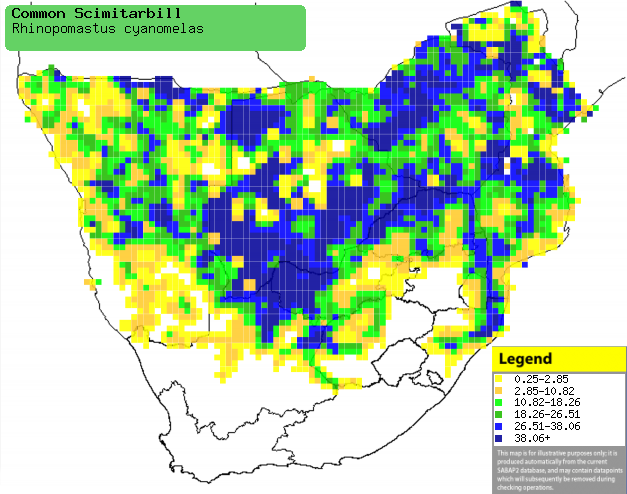|
Rhinopomastus cyanomelas (Common
scimitarbill, Scimitar-billed wood-hoopoe)
Swartbekkakelaar [Afrikaans]; Musokoto (also applied to
Green wood-hoopoe [Kwangali]; Yokoywana (also applied to Green wood-hoopoe)
[Tsonga]; Zuidafrikaanse boomhop [Dutch]; Irrisor namaquois [French]; Sichelhopf
[German]; Bico-de-cimitarra [Portuguese]
Life
> Eukaryotes >
Opisthokonta
> Metazoa (animals) >
Bilateria >
Deuterostomia > Chordata >
Craniata > Vertebrata (vertebrates) > Gnathostomata (jawed
vertebrates) > Teleostomi (teleost fish) > Osteichthyes (bony fish) > Class:
Sarcopterygii (lobe-finned
fish) > Stegocephalia (terrestrial
vertebrates) > Tetrapoda
(four-legged vertebrates) > Reptiliomorpha > Amniota >
Reptilia (reptiles) >
Romeriida > Diapsida > Archosauromorpha > Archosauria >
Dinosauria
(dinosaurs) > Saurischia > Theropoda (bipedal predatory dinosaurs) >
Coelurosauria > Maniraptora > Aves
(birds) > Order: Upupiformes
The Common scimitarbill is a common bird in the top half of southern Africa, living in tropical or subtropical arid woodland,
favouring miombo and Mopane trees. It feeds almost exclusively on insects,
running up and down trees, probing the bark with its bill. It uses natural or
barbet/woodpecker made holes in trees as nests. It lays 2-4 eggs, which are
incubated solely by the female, for 13-14 days. The chicks fledge at 21-24 days,
after which they leave the nest. The fledglings first flight is usually 10-50 m
long.
Distribution and habitat
Occurs from Kenya and Tanzania through eastern DRC, Angola,
Zambia and Malawi to southern Africa. Within southern Africa it is common in
Namibia, Botswana, Zimbabwe, Mozambique and northern South Africa. It generally
prefers tropical and subtropical
arid woodland, favouring miombo (Brachystegia) and Mopane (Colosphermum
mopane) trees; it avoids closed canopy
woodlands.
|
 |
|
Distribution of Common scimitarbill in southern Africa,
based on statistical smoothing of the records from first SA Bird Atlas
Project (©
Animal Demography unit, University of
Cape Town; smoothing by Birgit Erni and Francesca Little). Colours range
from dark blue (most common) through to yellow (least common).
See here for the latest distribution
from the SABAP2. |
Brood parasites
It has been recorded as host of the
Greater honeyguide.
Food
It feeds almost exclusively on
invertebrates, running up and down tree trunks and branches, probing the bark
with its bill while using its tail to stabilise itself (see images above).
Breeding
- Nests in tree
cavities, which can be either natural or old
woodpecker or barbet nests. They are usually about 30cm deep, with a 4 cm wide entrance. It
often competes with Ashy tits,
Crested barbets,
Acacia pied barbets and
Greater Blue-eared Starling for nesting sites.
It sometimes uses the same nest site repeatedly over multiple breeding
seasons.
- Egg-laying season is in all months except
July-August in Namibia (peak November-March), from August-December in
Zimbabwe (peak September-October) and from September-January in South Africa (peak October-November).
- It lays 2-4 eggs, which are incubated solely by the female for about 13-14 days.
- The chicks fledge at 21-24 days old, usually in the morning. Their first flights are
often just 10-50m long.
Threats
Not threatened, in fact common in southern Africa.
References
-
Hockey PAR, Dean WRJ and Ryan PG (eds) 2005. Roberts
- Birds of southern Africa, VIIth ed. The Trustees of the John Voelcker
Bird Book Fund, Cape Town.
|
